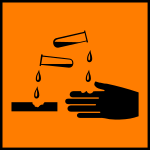Chemical burn
| Classification according to ICD-10 | |
|---|---|
| T20.– to T32.– | Burns or chemical burns |
| ICD-10 online (WHO version 2019) | |




Chemical burns (from “ etching ”) denotes damage to the skin or mucous membranes caused by chemical substances, usually strong acids or alkalis . The degree of damage depends on the type and concentration of the corrosive substances, but also on the amount and duration of exposure.
causes
Strong acids such as nitric acid, sulfuric acid and hydrochloric acid lead to so-called coagulation necrosis of the wetted skin or mucous membrane. The cell proteins coagulate in the same way as when heating a chicken egg in a pan. The clumping of the protein molecules prevents the corrosive liquid from penetrating deeper into the tissue. In contrast, caustic burns ( colliquation ) cause so-called colliquation necrosis , in which the damaged tissue is liquefied. As a result, the caustic liquid, so to speak, paves its way into the depths; Chemical burns from alkaline solutions therefore lead to far more extensive damage.
Symptoms
In the context of chemical burns, similar to burns , the focus is on the loss of fluid in the area of the contact point. In addition, many corrosive substances are also toxic to the human organism. The loss of fluid and severe pain can lead to shock ( hypovolemic shock ). In the case of chemical burns in the area of the mouth or throat, swellings and thus narrowing of the airways can occur. An impending respiratory failure is life threatening for the patient. In addition, swallowing acids or alkalis can injure esophageal veins and lead to excessive blood loss in the stomach. Chemical burns in the eye area (especially from quicklime ) often lead to clouding of the cornea and thus to blindness within a very short time .
treatment
As a first measure, chemical burns on the skin are rinsed with plenty of running water. Pronounced chemical burns require treatment by the rescue service and an emergency doctor.
In the case of chemical burns to the eyes, it is important that the eye is rinsed for a long time with plenty of water and that an ophthalmologist is consulted immediately, especially in the case of burns from unslaked lime (fresh cement, mortar - not drilling / flex dust from it). Unslaked lime creates a highly caustic lye, which is why the ophthalmologist may have to remove any residues of the product from the cornea under a microscope.
If a chemical laboratory has fresh, one percent sodium hydroxide solution (in case of acid burns to the eyes) or fresh one percent boric acid (in case of chemical burns from alkaline solutions) for eye wash bottles, these solutions can also be used for eye rinsing. As a rule, however, rapid rinsing with plenty of water or commercially available eye rinsing solutions (phosphate buffer solutions) will have to be carried out, especially since in the event of an accident there is neither time nor rest to prepare such a rinsing solution freshly and precisely balanced.
If there is a burn in the mouth and throat area, a poison control center should be contacted before further measures. Possible measures can be diluting measures or the administration of medicinal charcoal or defoamers. Vomiting can lead to complications as the chemical will again pass through the affected area (the stomach is more used to an acidic environment than the esophagus ).
Regulation and prevention
In a scientific opinion, the High Council of Health of Belgium provides an overview of the products that contain corrosive substances and that have been approved for consumer use in Belgium, as well as the risks associated with these products. The report suggests protective measures for consumers and gives recommendations for the different phases of formulation / regulation / marketing / application and post-application up to the monitoring of the products.
Therapeutic use
Corrosive agents such as zinc chloride and other corrosive agents used in the form of corrosive powder (Middle High German etzpulver , Middle Latin pulvis corrosivum ) were also used in medicine for the treatment of skin ulcers such as cancerous ulcers.
See also
Web links
- Chemical burn at emedicine.com (English)
Individual evidence
- ↑ Klaus-Jürgen Bauknecht, Joachim Boese-Landgraf: Wounds, wound healing, wound healing disorders, wound treatment, tetanus prophylaxis. In: Rudolf Häring, Hans Zilch (Hrsg.): Textbook surgery with revision course. (Berlin 1986) 2nd, revised edition. Walter de Gruyter, Berlin / New York 1988, ISBN 3-11-011280-9 , pp. 7-17, here: p. 9.
- ↑ Human exposure to caustic and / or corrosive substances (acids and bases). (PDF) Avis du Conseil Superieur de la Sante N ° 9108. Conseil Supérieur de la Santé, November 2015, accessed on December 2, 2015 .
- ^ Hanna K. Probst, Axel W. Bauer : pioneer and companion of new surgical therapy concepts. Tumor pathology in gynecology during the second half of the 19th century. In: Specialized prose research - Crossing borders. Volume 10, 2014, pp. 89–110, here: p. 96.
- ↑ Jürgen Martin: The 'Ulmer Wundarznei'. Introduction - Text - Glossary on a monument to German specialist prose from the 15th century. Königshausen & Neumann, Würzburg 1991 (= Würzburger medical-historical research. Volume 52), ISBN 3-88479-801-4 (also medical dissertation Würzburg 1990), p. 127 ( etzen , etzpulver , etzte ).